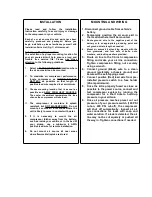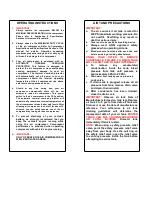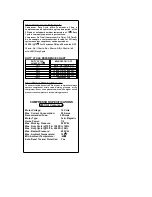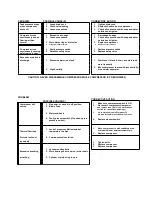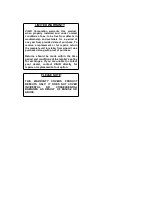
OPERATING INSTRUCTIONS
1.
IMPORTANT:
Always operate the compressor BELOW the
MAXIMUM PRESSURE RATING of the compressor.
Please refer to Application & Specifications
Sections of this manual for details.
2.
Always observe the MAXIMUM DUTY CYCLE
of the air compressor. Refer to Compressor
Applications and Specifications Section of this
manual for details. Operation exceeding
maximum pressure ratings and or duty cycle
will result in damage to air compressor.
3.
Your air compressor is equipped with an
AUTOMATIC
THERMAL
OVERLOAD
PROTECTOR. This feature is designed to
protect the air compressor from overheating
causing permanent damage to your air
compressor. The thermal overload protector
will automatically cut off power to your air
compressor should the internal operating
temperature of the air compressor rise above
safe levels during excessive use.
4.
Should at any time during use, your air
compressor automatically shuts off; do not
attempt to restart air compressor. Turn power
switch to the air compressor to the OFF position.
The automatic thermal overload protector will
automatically reset when internal temperature of
the air compressor drops below safe levels. After
allowing air compressor to cool off for about 30
minutes, you can safely resume use of the air
compressor by turning on the air compressor.
5.
To prevent discharge of your vehicle’s
battery, we strongly recommend that you
keep the vehicle’s engine running while
using the air compressor. Compressor
performance is enhanced when operating
compressor with vehicle’s engine running.
6.
IMPORTANT:
ONLY OPERATE THE AIR COMPRESSOR IN
WELL-VENTILATED AREAS.
AIR TANK PRECAUTIONS
IMPORTANT:
a. The air source kit air tank is rated for
200 PSI maximum working pressure. Do
not overfill. Overfilling may result in
death or serious injury.
b.
Tank is not to be used as a breathing device.
c. Always wear ANSI approved safety
glasses when operating air tank.
d.
Bleed pressure from tank after each use, and
before servicing or adding attachments.
DRAIN TANK OFTEN TO REMOVE
CONDENSATE. FAILURE TO DRAIN TANK
WILL ALLOW TANK TO RUST INTERNALLY.
a. To remove any accumulated
condensation inside the tank, bleed
pressure from tank until pressure is
approximately 5 PSI to 20 PSI.
b.
Drain water from tank by opening the drain
cock valve.
c . If drain cock is plugged, release all air
pressure from tank, remove drain valve
and clean, then reinstall.
d. After condensate has been drained,
close the drain cock.
IMPORTANT:
Observe air tank Date of
Manufacture (stamped on tank leg). Replace
air tank 2 to 5 years from date air tank was
first used, or use the date of manufacture as
reference. Your adherence to air tank
draining guidelines will determine the
replacement date of your air tank.
RUSTED
TANKS CAN FAIL
CAUSING EXPLOSIONS
OR FATAL INJURIES.
Discard tank
immediately if tank is
rusted.
NOTE:
When using a safety pressure relief
valve, point the safety pressure relief valve
away from your body. Use the pull ring on
the safety relief valve; open the relief valve
to vent any pressure inside the tank before
attempting to service tank.


